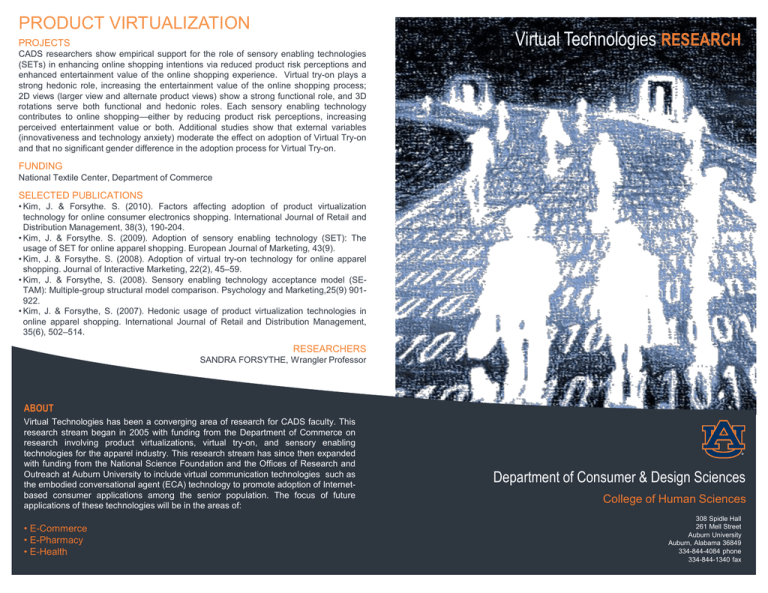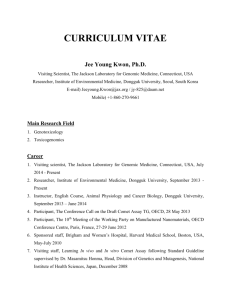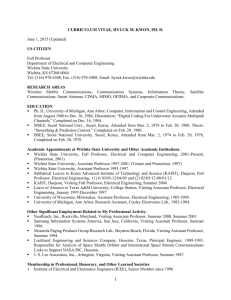Virtual Technologies Research
advertisement

PRODUCT VIRTUALIZATION Virtual Technologies RESEARCH PROJECTS CADS researchers show empirical support for the role of sensory enabling technologies (SETs) in enhancing online shopping intentions via reduced product risk perceptions and enhanced entertainment value of the online shopping experience. Virtual try-on plays a strong hedonic role, increasing the entertainment value of the online shopping process; 2D views (larger view and alternate product views) show a strong functional role, and 3D rotations serve both functional and hedonic roles. Each sensory enabling technology contributes to online shopping—either by reducing product risk perceptions, increasing perceived entertainment value or both. Additional studies show that external variables (innovativeness and technology anxiety) moderate the effect on adoption of Virtual Try-on and that no significant gender difference in the adoption process for Virtual Try-on. FUNDING National Textile Center, Department of Commerce SELECTED PUBLICATIONS • Kim, J. & Forsythe. S. (2010). Factors affecting adoption of product virtualization technology for online consumer electronics shopping. International Journal of Retail and Distribution Management, 38(3), 190-204. • Kim, J. & Forsythe. S. (2009). Adoption of sensory enabling technology (SET): The usage of SET for online apparel shopping. European Journal of Marketing, 43(9). • Kim, J. & Forsythe. S. (2008). Adoption of virtual try-on technology for online apparel shopping. Journal of Interactive Marketing, 22(2), 45–59. • Kim, J. & Forsythe, S. (2008). Sensory enabling technology acceptance model (SETAM): Multiple-group structural model comparison. Psychology and Marketing,25(9) 901922. • Kim, J. & Forsythe, S. (2007). Hedonic usage of product virtualization technologies in online apparel shopping. International Journal of Retail and Distribution Management, 35(6), 502–514. RESEARCHERS SANDRA FORSYTHE, Wrangler Professor ABOUT Virtual Technologies has been a converging area of research for CADS faculty. This research stream began in 2005 with funding from the Department of Commerce on research involving product virtualizations, virtual try-on, and sensory enabling technologies for the apparel industry. This research stream has since then expanded with funding from the National Science Foundation and the Offices of Research and Outreach at Auburn University to include virtual communication technologies such as the embodied conversational agent (ECA) technology to promote adoption of Internetbased consumer applications among the senior population. The focus of future applications of these technologies will be in the areas of: • E-Commerce • E-Pharmacy • E-Health Department of Consumer & Design Sciences College of Human Sciences 5432 Any Street West Townsville, State 54321 555.543.5432 ph 555.543.5433 fax www.yourwebsitehere.com 308 Spidle Hall 261 Mell Street Auburn University Auburn, Alabama 36849 334-844-4084 phone 334-844-1340 fax VIRTUAL COMMUNICATION THROUGH INTELLIGENT VIRTUAL AGENTS Benefiting the senior population in Alabama and beyond SELECTED PUBLICATIONS PROJECTS & APPLICATIONS E-COMMERCE E-commerce websites involve multidimensional information processing and complex decision-making, and their use demonstrates a significant age-based digital divide. This project investigates, three aspects of agent interactions with older users: 1) locus of control (agent vs. user), 2) interactional style (functional vs. relational), and 3) modality of exchange (voice, text, mulitmodal) through a series of controlled experiments with over 200 older users. The purpose is to examine the effectiveness of the above in: 1) reducing cognitive barriers (reducing information load, increasing navigation convenience and information search and retrieval ease), 2) reducing social-psychological barriers (enhancing control and efficacy, trust, and perception of social support), and 3) increasing Internet technology use intent in e-commerce environments. FUNDING National Science Foundation AU Office of Outreach AU Office of Research E-PHARMACY • Chattaraman, V., Kwon, W.-S., & Gilbert, J. E. (2012). Virtual agents in retail websites: Benefits of simulated social interaction for older users. Computers in Human Behavior, 28, 2055-2066. • Shim, S., Kwon, W.-S., Chattaraman, V., & Gilbert, J. E. (2012). Virtual sales associates for mature consumers: Technical and social support in e-retail service interactions. Clothing and Textiles Research Journal, 30(3), 232-248. • Chattaraman, V., Kwon, W.-S., & Gilbert, J. E. (in Press). Internet use and perceived impact on quality of life among older adults: A phenomenological investigation. The International Journal of Health, Wellness and Society. • Chattaraman, V., Kwon, W.-S., Gilbert, J. E., & Shim, S. I. (2011). Virtual agents in e-commerce: Representational characteristics for seniors. Journal of Research in Interactive Marketing, 5(4), 276-297. E-pharmacies can enhance healthcare management autonomy and efficacy among seniors by offering prescription management services. However, an agebased digital divide exists in e-pharmacy usage. In this project, virtual agents will employ (1) non-verbal aids through deictic movement and hand gestures and coordinated visual highlighting of specific content; and (2) verbal aids in procedural and informational tasks on pharmacy websites. The effectiveness of the agent aids in enhancing e-pharmacy literacy, psychological, and behavioral outcomes among seniors with diverse characteristics will be measured. • Chattaraman, V., Kwon, W.-S., Gilbert, J. E, Darnell, S. (2012, September). Locus of control in conversational agent design: Effects on older users’ interactivity and social presence. Proceedings of the 12th International Conference on Intelligent Virtual Agents, Santa Cruz, CA. • Kwon, W.-S., Chattaraman, V., Shim, S. I., Alnizami, H., & Gilbert, J. (2011, July). Older user-computer interaction on the Internet: How conversational agents can help. In J.A. Jacko (Ed.), HumanComputer Interaction, Part II: Proceedings of the 14th HCI International 2011 Conference (pp.533– 536). Berlin, Heidelberg: Springer-Verlag. • Kwon, W.-S., Chattaraman, V., & Gilbert, J. E. (2010, April). Effects of conversational agents in retail websites on aging consumers’ interactivity and perceived benefits. Proceedings of the CHI 2010 Workshop on Senior Friendly Technologies: Interaction Design for the Elderly. Atlanta, GA. VIRTUAL AGENTS • ANIMATED EMBODIMENT • ARTIFICIAL INTELLIGENCE • MULTIMODAL COMMUNICATION • TWO-WAY INTERACTION • SOCIAL DIALOG • DYNAMIC, REALTIME SUPPORT RESEARCHERS VEENA CHATTARAMAN, Associate Professor WI-SUK KWON, Human Sciences Associate Professor of Retailing










